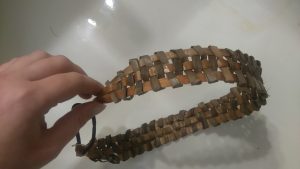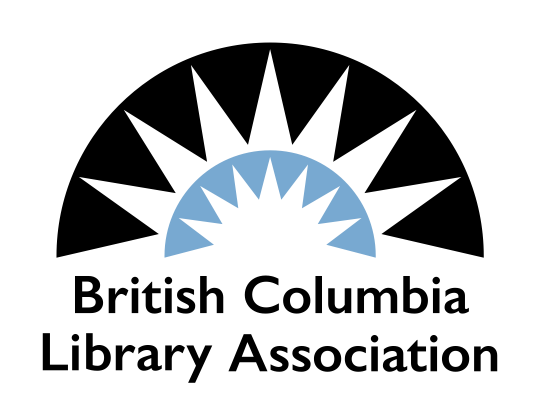
A herringbone traditional cedar weaving headband completed by hundreds of participants in VIRL’s 2021 Indigenous People’s Day Maker Workshop with Penelakut and Snuneymuxw weaver Violet Elliott/Snu’meethia.
As one of the most racially non-diverse professions, librarians have a lot of work to do when it comes to building equity, diversity, and inclusion (EDI) into our daily work. You don’t need a human resources degree to see how gaps in professional EDI and service delivery correlate with an overwhelmingly white professional staff. Taking a close look at our roots in colonial, and hence Eurocentric, notions of librarianship requires a critical lens when considering Indigenous peoples in BC and decolonizing state-funded library spaces. With a long history of excluding on-reserve residing patrons, traditional knowledge, and those facing systemic barriers to access, reconciliation work as called for in the Truth and Reconciliation Commission Report’s 94 Calls to Action are an imperative responsibility for every library regardless of type, size, or location. Furthermore, open access is about more than just written materials but open access to resources, voices, and knowledge that have long been inaccessible in public libraries.
As the great-granddaughter of Jewish refugees that fled brutal persecution and anti-Semitism in Eastern Europe, I come to this work haunted by own family’s suffering and eager to make significant amends toward past atrocities and ongoing injustices in my adopted homeland. If we’re serious about building welcoming and safe spaces for BIPOC communities, we must rethink and decolonize our library programs and services by going beyond empty land acknowledgements and token celebrations.
With the onset of the COVID-19 pandemic in 2020, I set about studying how 21st century pandemic-friendly sharing could be the golden opportunity for libraries as reconciliatory learning spaces. We were now the hub that everyone was flocking to for free content. Time to live up to CFLA’s Committee on Truth and Reconciliation’s Recommendation #6![1] As an MLIS student at the time, it made me ask these questions:
- How can public library makerspaces better incorporate Indigenous-led programs during a pandemic?
- How can we widen multi-literacy mandates to include traditional knowledge?
- How do we as librarians engage in this work in a meaningful way, in line with TRC calls to action?
Creativity Commons Indigenous Maker Workshops
In 2019, I joined the Creativity Commons team, a library makerspace at Vancouver Island Regional Library (VIRL), as an Information Technician and I began to connect with local Snuneymuxw Elders and Indigenous community members through local First Nation organizations and community contacts. Cold calls are always nerve-racking but as a new library branch, marketing and building capacity for many demographics in Nanaimo was part of a self-imposed initiative to address systemic barriers to access and make EDI a reality in my new workplace.
Grassroots community-led engagement included listening to the specific interests and needs of community members and culminated in a mutual vision for hands-on traditional maker workshops. One example was a drum-making workshop led by Plains Cree artist Felix Thomas in December 2019. We built drums using traditionally sourced sinew and hides to provide ten drums as a makerspace resource to compliment facilities such as a recording studio and free community meeting spaces. Since gifting your first drum is part of traditional protocol, it matched the library’s mission to provide creative resource-sharing where the gifted drums could flourish through open access. Interest and feedback was overwhelming and positive. Indigenous-identifying community members told us of their newfound cultural pride, confidence-building, connections, and awareness of all the library has to offer. This momentum and thirst for diversifying the library makerspace translated into leading system-wide pandemic-friendly programming for Indigenous People’s Day this past June.
In April, at the height of the third wave, I set out to connect with local textile makers that identified as Indigenous. The pandemic was no excuse for not celebrating Indigenous culture in a hands-on and meaningful way, full of family-friendly STEAM applications. I was determined to build cultural awareness and combat social isolation, especially in remote and rural areas within VIRL’s vast service area. While virtual tech workshops and family storytimes are great temporary stand-ins for in-person programming, we can’t forget about addressing EDI and building reconciliatory learning capacity by incorporating Indigenous-led initiatives into our virtual offerings.
The workshop would be a hands-on learning opportunity patrons could tune into online and make from home. I could film the workshop inside the library recording studio and make it available on VIRL’s YouTube channel. It also required developing “Take and Make Kits,” something many of us are now accustomed to for curbside or in-branch pickup with limited contact. These kits however, contained sacred cedar inner bark strips gathered in the traditional manner by Elder and basket weaver Violet Elliott/Snu’meethia. A member of the Snuneymuxw, Penelekut, and Stz’uminus Nations, Violet also led the workshop, showcased her work, shared stories, and taught cultural knowledge around cedar trees, sinew and weaving in the program video. The herringbone headband project she chose was accessible to a variety of age groups and abilities and could be made in under an hour. I made a headband alongside her, asking pertinent questions in what became a very moving and beautiful experience.
I managed to film the workshop in under three hours with a second camera gathering close-up footage of her hands as she worked. I then spent time editing it down to under two hours and adding the Green Screen background.
Violet was paid an honorarium and VIRL also paid for enough cedar for 100 kits which was the maximum she could feasibly provide. When this wasn’t enough given the popularity of the program, I obtained her permission to use ribbon instead of cedar so more participants could join in on this hands-on learning and traditional knowledge transmission opportunity. We had YouTube views in a 30-day window that outperformed the rest of VIRL’s pandemic programming statistics. About half of the kits went to Indigenous-identifying families (self-identified upon web registration), and we prioritized our marketing and partnership with Nanaimo Art Gallery, who provided funding, around targeting Indigenous community members. This facilitated inter-generational knowledge transmission and empowered cultural connections for the largely under-served Indigenous youth demographic that lack free opportunities for cultural engagement from non-Indigenous organizations.
Knowledge & Promise-keeping
Another consideration for bringing Indigenous-led programs into the library is the issue of rights to the knowledge you are showcasing. It’s also very important to clearly define deliverables for all parties and that we as libraries and individuals follow-through on our promises. If you’re sick the day of the workshop, ensure you’ve planned for a colleague to step in that’s well aware of the expectations the library must fulfill. And the same goes for a filmed workshop or program. How long will it be available? On which platforms will it be broadcast and who will receive rights to that material? How will we prioritize kits for Indigenous youth? Like much of community-led engagement, we must let Indigenous peoples tell us what they’d like to see, what their concerns are and make a plan together. Then, ensure it’s confirmed and communicated effectively so it can be honoured by all staff, including marketing and communications departments.
In this case, I had multiple phone check-ins with Violet about her concerns and workshop logistics. Email wasn’t her preferred mode of communication so I adapted to her needs and followed up in a manner that built trust and comfort when sharing in difficult conversations about stolen and appropriated knowledge or how important local First Nation youth engagement was to her. I worked with VIRL staff to collaborate on getting the kits out to all 39 branches before the workshop aired on June 21. This meant clear messaging on what these kits were for, where to find more info and which registrants were coming to pick them up. In the event a registrant didn’t pick-up by a specified date, I instructed staff to make a display and spark conversations around the workshop to find eager new participants. We didn’t want any sacred cedar going to waste and had a limited window for participation (30 days). However, very few kits weren’t picked up.
Violet let me know that she didn’t want the library to have rights to the workshop in perpetuity. We had a conversation and she agreed that 30 days would be a reasonable time period for kits to get to remote branches and allow participants enough time to pick-up and complete their headband. I explained how no one would be able to download or edit her workshop in any way while it was live. And it was so rewarding to receive very positive and inspiring evaluative feedback.
Building capacity and making Indigenous-led programming a pandemic priority as part of an important national celebration is one way of developing reconciliatory learning spaces. It’s also important we avoid tokenism and make Indigenous-led programming a priority beyond Indigenous People’s Day. I’ve organized an outdoor drum ceremony to welcome the ten drums made in 2019 into our collection according to protocol through a birthing ceremony. Actively listening to Elders by checking in on them has offered valuable insights into what pandemic-friendly, inclusive programs can look like. The drum ceremony is one example and has grown to a small monthly in-person drum circle led by a local knowledge-keeper that utilizes the gifted drums made in 2019 as a community open access resource. The circle is also built around providing a safe space for traditional learning and Hul’qumi’num language transmission.
Cultivating EDI through relationship-building can lead to meaningful changes in LIS toward truth and reconciliation, and there’s no need to postpone until post-pandemic. It needs to come from within each of us, to do the hard professional development work of learning about the effects of colonization and residential schools that wasn’t talked about, to make the effort to reach out, and sometimes just listen to those who have been excluded from government spaces historically, whose very cultural practice and language was outlawed, who need us to advocate for opportunities to share culture and traditions that need preserving through hands-on knowledge transmission, multi-literacy life-skill development, and inter-generational learning as part of the vital life-long learning that keep libraries, well, libraries.
I’d like to conclude by saying, I am grateful to colleagues past and present who have provided mentorship and support to pursue Indigenous-led community work and to Indigenous Elders, artists, and knowledge-keepers who I have had the honour of building relationships with. Views expressed here are my own.
Dalia Levy has over a decade of experience working in libraries including as a Library Technician with UBC’s X̱wi7x̱wa Library, Vancouver Public Library and presently as a Customer Services Librarian with Vancouver Island Regional Library in the Creativity Commons, a library makerspace. She works, plays, and crafts on unceded Snuneymuxw, Sna-Naw-As, and Stz’uminus territory on beautiful Vancouver Island (Nanaimo, BC).
[1] CFLA-FCAB. (2017). Truth and Reconciliation Committee Report and Recommendations. http://cfla-fcab.ca/wp-content/uploads/2018/10/Truth-and-Reconciliation-Committee-Report-and-Recommendations-ISBN1.pdf

